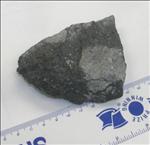May 1998
Meteorites often look different from the rocks that surround them. They often look black because of the presence of a fusion crust, the result of surface melting caused by friction as they plunge through our atmosphere. The flight through the atmosphere may also cause bowl-shaped depressions or thumbprinting (regmagyphts) of the surface. And, because almost all meteorites contain iron, they feel heavy for their size and will attract a magnet.
Meteorites often look different from the rocks that surround them. They often look black because of the presence of a fusion crust, the result of surface melting caused by friction as they plunge through our atmosphere. The flight through the atmosphere may also cause bowl-shaped depressions or thumbprinting (regmagyphts) of the surface. And, because almost all meteorites contain iron, they feel heavy for their size and will attract a magnet.
So if you find a black, heavy rock that looks different than surrounding rocks — perhaps with a thumbprinted surface, and attracts a magnet — you may have discovered a meteorite! If you think you have, visit your nearest museum that has meteorites on display, or send it or a portion of it (at least several grams) to:
| The Institute of Meteoritics Department of Geology University of New Mexico Albuquerque, NM 87131 |
or | Lunar and Planetary Laboratory Space Sciences Building University of Arizona Tucson, AZ 85721 |
— JIM PHILLIPS










